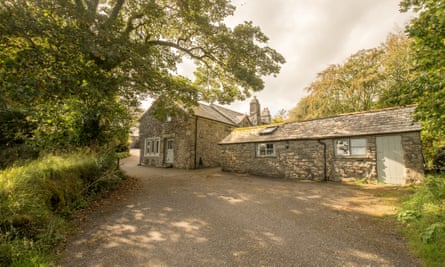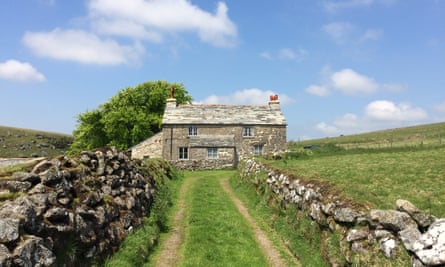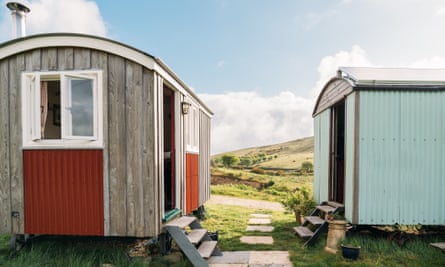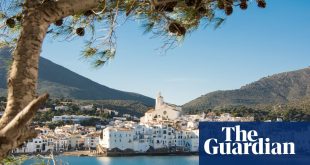Forget satnav, the best way to find your way around the wild granite uplands of Cornwall’s Bodmin Moor is to invest in an old-fashioned Ordnance Survey map. That’s exactly what writer Louis de Bernières did when he was exploring the setting for his new novel Light Over Liskeard, a “heartwarming” dystopian fantasy in which the hero (a quantum cryptographer called Q) seeks refuge and self-sufficiency in a remote moorland farmhouse while waiting for the collapse of civilisation.
The author of the best-selling Captain Corelli’s Mandolin chose Bodmin Moor, he says, because “it’s one of the furthest places from any centres of population”. The moor is ringed by small towns (including Liskeard) and scattered with tiny huddled villages, but there are no cities for miles, no handy motorways and not much in the way of reliable phone reception (the notion of life off-grid seems very real up here among the craggy tors of the High Moor). And in one of Cornwall’s least-visited regions, it is easy to find yourself completely alone.
On a recent return to my moorland roots (I was born in Liskeard), I walked to the top of deserted Leskernick Hill. Standing among sheep and gorse and the littered remnants of ancient hut circles, I watched clouds darken over the rocky summit of Brown Willy (Cornwall’s highest point, at 419 metres). There was a short sharp shower– then a rainbow. I was a long way from the Cornwall most of us think we know.

Like many of the county’s visitors, Louis de Bernières had his first introduction to Bodmin Moor in glimpses of bewitching scenery from the A30. Then, a few years ago, he attended the Bodmin Moor Poetry Festival. “I took some walks around the moor,” he told me. “I found it bleak and mysterious, a land of ghosts and ruins – full of abandoned mines and quarries – a spooky, atmospheric and very strange place to set a story in. It was almost like being in another country.”
An Area of Outstanding Natural Beauty, Bodmin Moor bristles with stories of its own: the place is awash with tumuli, bronze age standing stones, cairns and quoits (the Cornish word for megalithic tombs). On craggy granite tors, relics of prehistoric settlements rub shoulders with the remnants of 19th-century engine houses and broken mineral railways, mapping the passage of the region’s tin and copper mining booms (the area forms part of the Cornish Mining world heritage site). The rivers Looe, Lynher, Fowey and Camel all rise on the moor.
According to legend, the stack of granite plates known as the Cheesewring is the work of giants. And in nearby Minions, the three rings of standing stones they call the Hurlers (probably the best examples of ceremonial circles in the south west, say English Heritage) are men turned to stone for playing the game on a Sunday.
De Bernières was particularly drawn to the moor’s connections with King Arthur – which is why one of his characters is an “anachronistic Arthurian knight who’s waiting for the return of the king”. Readers will find Bedwyr Bedryant on horseback on the shores of Dozmary Pool – the serene, rather ghostly lake in whose depth, the legend says, Arthur’s sword Excalibur lies in the deep.

De Bernières writes lyrically about moorland mists (“a quiet ocean of vapour”), its wild, whinnying ponies, the peaks of the High Moor, its “exhilarating beauty”, but is his version of this rugged Cornish landscape enough to attract more visitors – will Light Over Liskeard do for Bodmin Moor what Captain Corelli did for Kefalonia?
Perhaps not, or not in the same way. The moor’s ravishing beauty is all about nature in the raw. Those who love the place embrace its bleak landscapes and unpredictable weather – in meteorological language, they call it “peninsular convergence”. Caradon Hill, which looms over Liskeard, is the soggiest place in Cornwall. Hiking across damp heathland in stout boots and waterproofs is never going to have quite the same appeal as a beach on a Greek island. And the novel offers no obvious Light Over Liskeard trails.

The book has many entirely fictional elements – marinated mouse kebabs, aurochs, tame lynxes – but he has name-checked a few real places. Leskernick Hill and Bray Down, in High Moor territory to the north, are seen from a distance; the novel is more rooted in the south around Brown Gelly or Stowe’s Hill (home of the Cheesewring Quarry) and the villages of St Neot, St Cleer and Upton Cross. This is where rough granite tors melt into grassy heathland or slip into deep valleys, green with temperate rainforest, oak trees clad in velvety moss and bearded with lichen. Sheep and shaggy brown cows wander on roadside verges, confined only by cattle grids and low drystone walls.
One of four old mining towns that frame the perimeter of the moors (alongside Callington, Bodmin and Launceston), Liskeard earns its place in the novel because, says the author, “I realised, when I looked at my OS map, that if you climbed the tor where I’ve put my people, Liskeard is the only town of any size you’d be able to see.”
Yelland Tor, where he put his people, is a fiction, and he won’t say which of the real tors it’s based on (“I don’t want everyone to know!”). There are lots of options, but having pored over the gradients on my own OS map (Landranger, number 201), I’m going for somewhere around Berry Down, a beginner’s-level tor between the reservoirs at Colliford and Siblyback. From the top, across a panorama of moorland, bright with vivid autumn colour, I could just about see Liskeard (pronounced Liskard, by the way, not Liskeerd).
The novel doesn’t actually say much about the place. The Everest Tandoori in Pike Street gets a mention (though personally I prefer Himalayan Spice on Castle Street). But I’m hoping the title alone will shine a bit of light on my home town.

Liskeard is ordinary, bypassed, roofed in Delabole slate, and a little run-down (the livestock market closed in 2017). From the station (on the Paddington-to- Penzance route), the scenic Looe Valley Line, a former mineral railway, trundles down to the sea at Looe, eight miles to the south. There is a limited rural bus service (for the moors, there’s the 78 to Upton Cross). The shops on pedestrianised Fore Street are overlooked by a magnificent Italianate clock tower (built in 1859 and still wound by hand twice a week).
The granite Guildhall, the ornamental fountain on the Parade, the former Webb’s Hotel (now an office for the Cornish Times) are among the many handsome architectural legacies of the town’s 19th-century mining boom. The Old Cornwall Society hangs out in the late-medieval Stuart House (featured on the free Liskeard Heritage Trail leaflet).
Liskeard is a “nice little town”, says de Bernières. By moorland-village standards, it is a hub of civilisation, but those who, like his characters, need to head for the wild can reach the edge of the moor on foot in just over an hour.
Where to stay
Mennabroom Farm

This edge-of-the-moorland guesthouse is best found by counting the number of cattle grids between St Neot and Warleggan. The 13th-century farmhouse – said to be the oldest on the moor – is all low beams, granite lintels and thick-stone walls; mullioned windows overlook apple and plum trees, there are woodpeckers in the garden, two-friendly labradoodles, a wood burner in a guest lounge and homemade marmalade for breakfast. Ian and Deborah Wheatley’s 15 acres encompasses a valley of temperate rainforest, a beaver dam on a stream and three self-catering cottages.
Doubles from £105 B&B, mennabroom.com
Leskernick Cottage

Access to this isolated off-grid retreat entails a bone-shaking ride along a mile and a half of open moorland (the owners recommend a 4×4 or a vehicle with good ground clearance). The nearest cottage to Brown Willy, it sits at the foot of Leskernick Hill, surrounded by sheep and wild ponies. It has three bedrooms, solar-power, woodburning stoves, a bore-hole water supply and rugged moorland views.
From £795 a week (short breaks from £150 a night), leskernick.com
Diddlylake Shepherd’s Hut

This middle-of-nowhere small-holding close to Brown Gelly and Dozmary Pool offers an “escape from civilisation” in a pair of homely off-grid huts with a compost toilet, solar power, spring water and inky night skies (this area of the moorland is a designated dark sky reserve).
Sleeps two from £65 a night, two-night minimum, coolstays.com
Wheal Tor Hotel
Claiming to be the highest licensed premises in Cornwall, this tor-side hotel (the former home of copper mine manager Captain Seccombe) is in the Caradon Hill mining district and offers basic rooms, “Hobbit House” glamping and a restaurant with splendid moorland views.
B&B from £120 a night: bodminmoorhotel.co.uk
 Top Naija News: Nigerian News, Breaking News Nigeria and World News Top Naija News is a daily news publication in Nigeria, delivering the latest breaking news in Nigeria and around the world.
Top Naija News: Nigerian News, Breaking News Nigeria and World News Top Naija News is a daily news publication in Nigeria, delivering the latest breaking news in Nigeria and around the world.



